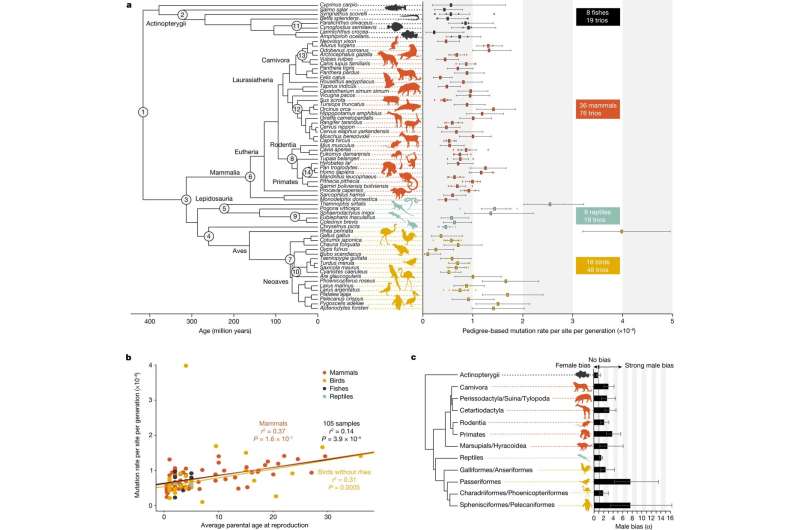March 3, 2023 report
This article has been reviewed according to Science X's editorial process and policies. Editors have highlighted the following attributes while ensuring the content's credibility:
fact-checked
peer-reviewed publication
trusted source
proofread
Determining the tempo of evolution across species

Scientists from Denmark and China have estimated germline mutation rates across vertebrates by sequencing and comparing genetic samples from 151 mother, father, and offspring trios from 68 species of mammals, fishes, birds and reptiles. A bioinformatics pipeline was designed to read, analyze and compare the genome mutations that occur yearly and between generations in each species.
The research was published March 1, 2023, in the journal Nature.
Knowing the germline mutation rate could allow a greater understanding of evolutionary drivers and be used to estimate when a species first arose. Despite the variety of evolutionary paths seen in 68 different species, researchers found the germline mutation rate to be relatively conserved.
How fast a species evolves depends on the rate at which it accumulates mutations. Unlike somatic mutations that can occur in the DNA of any cell in the body but are never inheritable, germline mutations only occur in reproductive cells and are passed on to the next generation.
Individual germline mutation rates varied across all species in the study. While mutation rates per generation were found to be highest in reptiles, the difference between any of the four major classes of vertebrates was not statistically significant. Between species, birds had the most varied rates. More impactful was the amount of time between generations, age at maturity, and reproduction rates.
Species with higher long-term effective population sizes tended to have lower mutation rates per generation, while those with longer generation intervals had higher per-generation mutation rates.
The father's age was the most significant explanatory variable of increased variants among mammals and birds. The researchers explained, "Although most birds and mammals produce sperm cells continuously through time, reptiles and fishes tend to be seasonal breeders, producing sperm cells during a limited period before the mating season, which will tend to reduce differences in cell division numbers between males and females," allowing for less opportunity for mutations to occur.
While the germline mutation rates recorded the pace of species evolution, it is also an evolving parameter itself as life-history traits of the animals seem to play a role. With further research, scientists will continue to reveal the mechanisms that drive the tempo of evolution.
This latest study illustrates how much we can learn with a good design of experiments, robust access to next-generation gene sequencing machines, and a well-built bioinformatics pipeline to handle the tremendous amount of data required to thoroughly investigate even a small cross-section of evolving animals.
More information: Lucie A. Bergeron et al, Evolution of the germline mutation rate across vertebrates, Nature (2023). DOI: 10.1038/s41586-023-05752-y
Journal information: Nature
© 2023 Science X Network



















